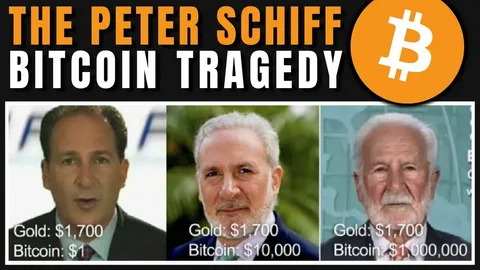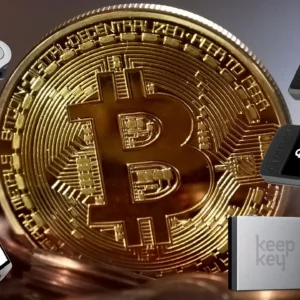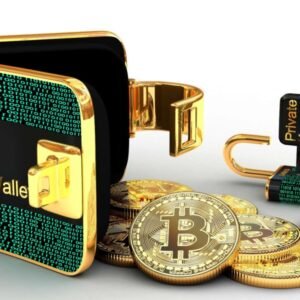For years, Schiff has been a vocal critic of Bitcoin, often referring to it as a bubble, a speculative asset, or even outright calling it “fool’s gold.” Recently, Schiff has gone a step further, suggesting that Bitcoin might not be the revolutionary digital gold its proponents claim it to be, but rather, just another “meme coin” in disguise. This comparison has stirred up a storm in the cryptocurrency world, sparking heated discussions among both Bitcoin believers and skeptics alike.
In this blog post, we’ll delve into Peter Schiff’s critiques of Bitcoin, explore his arguments, and analyze whether Bitcoin truly holds substance or if it’s just another trendy asset with the characteristics of a meme coin. By breaking down Schiff’s points, we aim to offer insights into one of the most controversial debates in the financial world. Let’s dive in.

Who Is Peter Schiff and Why Are His Critiques Important?
Before diving into the details of Schiff’s argument that Bitcoin might be a meme coin in disguise, it’s essential to understand who Peter Schiff is and why his opinions carry weight. Schiff is a prominent economist, financial commentator, and CEO of Euro Pacific Capital, known for his staunch advocacy of gold as the ultimate store of value. He gained significant attention during the 2008 financial crisis, where his accurate predictions about the housing bubble earned him credibility in economic circles.
Peter Schiff’s critiques of Bitcoin often revolve around its perceived lack of intrinsic value, extreme volatility, and speculative nature. To him, Bitcoin represents the antithesis of what a reliable store of value should be. Schiff frequently contrasts Bitcoin with gold, highlighting that while gold has stood the test of time for thousands of years, Bitcoin is still in its infancy, barely 14 years old, and lacks the historical precedent to be considered a true safe haven asset.
Schiff’s most recent assertion that Bitcoin is akin to a meme coin in disguise stems from his belief that much of Bitcoin’s value is derived from hype, marketing, and speculation rather than real utility or intrinsic value. This comparison has reignited debates over Bitcoin’s legitimacy, prompting both supporters and skeptics to reassess their perspectives.
Is Bitcoin a Meme Coin in Disguise? Examining Schiff’s Argument
To understand why Peter Schiff critiques Bitcoin as a potential meme coin, it’s crucial to break down what a meme coin is and how Bitcoin might (or might not) fit into that category. Meme coins are typically cryptocurrencies that gain popularity primarily through internet memes, social media hype, and the influence of online communities, rather than any groundbreaking technology or utility. Examples like Dogecoin and Shiba Inu have become poster children for this phenomenon, rising to prominence on the back of viral trends and endorsements from influencers like Elon Musk.
According to Schiff, Bitcoin exhibits several traits of a meme coin, including:
1. Hype-Driven Valuation
Schiff argues that much of Bitcoin’s value is derived from the “fear of missing out” (FOMO) and the belief that its price will continue to rise indefinitely. He claims that Bitcoin enthusiasts rely heavily on marketing, social media campaigns, and cult-like community support to drive demand, much like meme coins do. Schiff often points to the speculative frenzy surrounding Bitcoin during bull markets, where retail investors flood in, hoping to strike it rich. For Schiff, this speculative nature undermines Bitcoin’s credibility as a serious financial asset.
2. Lack of Tangible Utility
Another core aspect of Schiff’s critique is the idea that Bitcoin lacks real-world utility. While Bitcoin proponents tout its use as a decentralized currency and a hedge against inflation, Schiff contends that these claims don’t hold up under scrutiny. He argues that Bitcoin is too slow, energy-intensive, and impractical for everyday transactions compared to more efficient payment systems. In Schiff’s view, Bitcoin’s primary use case is speculative trading, much like meme coins that have little to no utility outside of their role as speculative assets.
3. Absence of Intrinsic Value
Perhaps the cornerstone of Schiff’s argument is his assertion that Bitcoin has no intrinsic value. Unlike gold, which has industrial applications and historical significance as a store of value, Bitcoin is entirely digital and lacks physical substance. Schiff likens Bitcoin to a meme coin in this regard, claiming that its value is based purely on collective belief rather than any inherent qualities.
While these points may resonate with Bitcoin skeptics, supporters counter that Bitcoin’s decentralization, security, and scarcity (thanks to its 21-million cap) give it unique properties that set it apart from meme coins. Additionally, Bitcoin’s growing adoption by institutional investors and its role as a hedge against inflation in some economies further distinguish it from purely speculative meme assets.
Bitcoin Supporters Respond: Why Bitcoin Is Not a Meme Coin
While Peter Schiff critiques Bitcoin as a meme coin in disguise, many in the cryptocurrency community vehemently disagree. Bitcoin supporters argue that Schiff’s comparison fails to consider several critical aspects of Bitcoin’s design, adoption, and long-term potential. Let’s explore the counterarguments.
1. Bitcoin’s Decentralized Network
Unlike meme coins, which are often created as a joke or for quick profit by a small group of developers, Bitcoin operates on a truly decentralized network. Its creation by the pseudonymous Satoshi Nakamoto and its subsequent development by a global community of developers distinguish it from most other cryptocurrencies. Meme coins, on the other hand, often rely on centralized control and limited innovation, making them far less robust than Bitcoin.
2. Scarcity and Monetary Policy
Bitcoin’s capped supply of 21 million coins is a defining feature that sets it apart from both fiat currencies and meme coins. This scarcity mimics the finite nature of gold and is one of the reasons Bitcoin is often referred to as “digital gold.” Meme coins, by contrast, typically have inflated or unlimited supplies, which can dilute their value over time.
3. Institutional Adoption
Another key difference is Bitcoin’s growing acceptance among institutions, governments, and businesses. Companies like Tesla and MicroStrategy have invested billions of dollars into Bitcoin, and nations such as El Salvador have even adopted it as legal tender. This level of adoption and integration into the global financial system is unprecedented for any meme coin and further undermines Schiff’s comparison.
4. Store of Value and Inflation Hedge
While Schiff argues that gold is the ultimate store of value, Bitcoin proponents counter that Bitcoin is emerging as a viable alternative in the digital age. In countries experiencing hyperinflation, such as Venezuela and Argentina, Bitcoin has become a lifeline for citizens seeking to preserve their wealth. Meme coins, with their high volatility and lack of utility, do not serve this purpose.
These points highlight the deep divide between Schiff’s critiques and the perspectives of Bitcoin advocates. Whether one sees Bitcoin as a revolutionary financial tool or a speculative bubble largely depends on their understanding of the technology and their faith in its long-term potential.
The Bigger Picture: What Does This Debate Mean for Investors?
The ongoing debate between Peter Schiff and Bitcoin enthusiasts offers valuable lessons for investors. Schiff’s critiques serve as a reminder to approach new technologies with skepticism and to thoroughly research any investment opportunity. His comparison of Bitcoin to a meme coin underscores the risks associated with speculative assets, which can experience dramatic price swings.
At the same time, Bitcoin’s defenders highlight the importance of innovation and the potential for disruption in traditional financial systems. Bitcoin’s rise has challenged the status quo, forcing institutions and governments to rethink how value is stored and transferred in the digital age.
For investors, the key takeaway is to strike a balance between caution and curiosity. While Schiff’s critiques may highlight valid concerns, dismissing Bitcoin entirely could mean missing out on one of the most significant financial innovations of the 21st century. Similarly, blind faith in Bitcoin without understanding its risks could lead to financial losses.
Conclusion: What’s Your Take on Peter Schiff’s Critiques?
The debate over Bitcoin’s legitimacy as a financial asset is far from over, and Peter Schiff’s critiques have added an interesting dimension to the discussion. By comparing Bitcoin to a meme coin in disguise, Schiff has challenged the cryptocurrency community to address the speculative nature of Bitcoin’s value and to prove its worth as a store of value and medium of exchange.
Whether you agree with Schiff or see Bitcoin as a revolutionary asset, this debate invites us to think critically about the future of money and the role of technology in reshaping global finance. The question remains: Is Bitcoin truly digital gold, or is it just another hype-driven trend destined to fade away?
What do you think about Peter Schiff’s critiques of Bitcoin? Is there merit to his comparison, or is he missing the bigger picture? Share your thoughts in the comments below!






